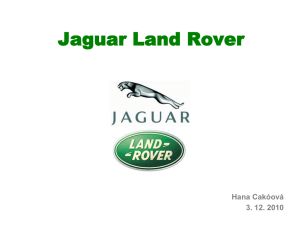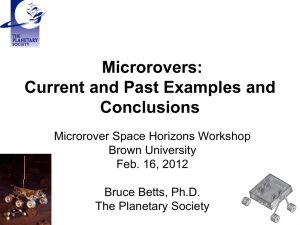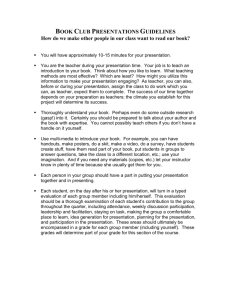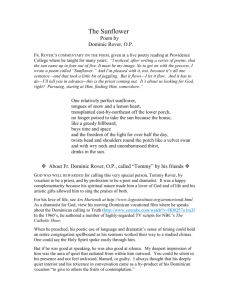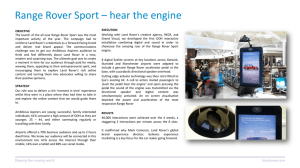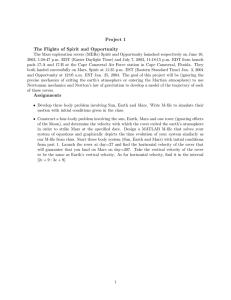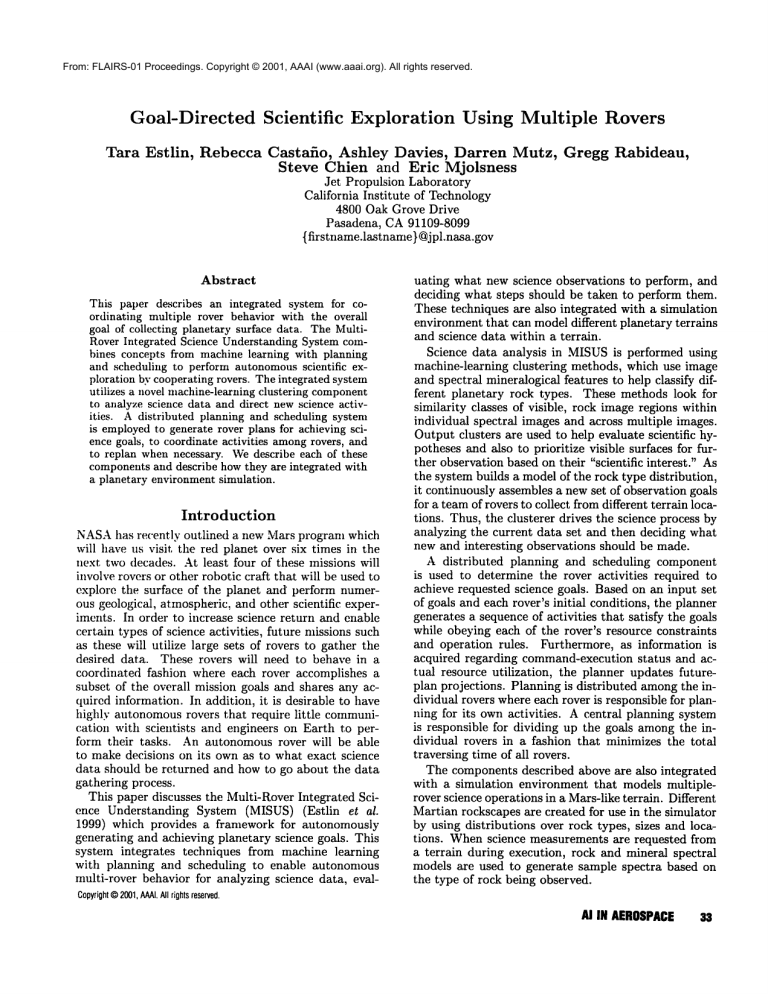
From: FLAIRS-01 Proceedings. Copyright © 2001, AAAI (www.aaai.org). All rights reserved.
Goal-Directed
Tara
Estlin,
Rebecca
Scientific
Exploration
Using Multiple
Castafio,
Ashley Davies,
Darren
Steve
Chien and Eric Mjolsness
Jet Propulsion Laboratory
California Institute of Technology
4800 Oak Grove Drive
Pasadena, CA 91109-8099
{firstname.lastname}@jpl.nasa.gov
Abstract
Tt~is paper describes an integrated system for coordinating multiple rover behavior with the overall
goal of collecting planetary surface data. The MultiRover Integrated Science Understanding System combines concepts from machine learning with planning
and scheduling to perform autonomousscientific exploration by cooperating rovers. The integrated system
utilizes a novel machine-learningclustering component
to analyze science data and direct new science activities. A distributed planning and scheduling system
is employedto generate rover plans for achieving science goals, to coordinate activities amongrovers, and
to replan when necessary. Wedescribe each of these
componentsand describe howthey are integrated with
a planetary environmentsimulation.
Introduction
NASAhas recently outlined a new Mars program which
will have us visit the red planet over six times in the
next two decades. At least four of these missions will
involve rovers or other robotic craft that will be used to
explore the surface of the planet and’ perform numerous geological, atmospheric, and other scientific experiments. In order to increase science return and enable
certain types of science activities, future missions such
as these will utilize large sets of rovers to gather the
desired data. These rovers will need to behave in a
coordinated fashion where each rover accomplishes a
subset of the overall mission goals and shares any acquircd information. In addition, it is desirable to have
highly autonomous rovers that require little communication with scientists and engineers on Earth to perform their tasks. An autonomous rover will be able
to make decisions on its own as to what exact science
data should be returned and how to go about the data
gathering process.
This paper discusses the Multi-Rover Integrated Science Understanding System (MISUS) (Estlin et al.
1999) which provides a framework for autonomously
generating and achieving planetary science goals. This
system integrates techniques from machine learning
with planning and scheduling to enable autonomous
multi-rover behavior for analyzing science data, evalCopyright
©2001,
AAAI.
Allrights
reserved.
Mutz,
Gregg
Rovers
Rabideau,
uating what new science observations to perform, and
deciding what steps should be taken to perform them.
These techniques are also integrated with a simulation
environment that can model different planetary terrains
and science data within a terrain.
Science data analysis in MISUSis performed using
machine-learning clustering methods, which use image
and spectral mineralogical features to help classify different planetary rock types. These methods look for
similarity classes of visible, rock image regions within
individual spectral images and across multiple images.
Output clusters are used to help evaluate scientific hypotheses and also to prioritize visible surfaces for further observation based on their "scientific interest." As
the system builds a modelof the rock type distribution,
it continuously assembles a new set of observation goals
for a team of rovers to collect from different terrain locations. Thus, the clusterer drives the science process by
analyzing the current data set and then deciding what
new and interesting observations should be made.
A distributed
planning and scheduling component
is used to determine the rover activities required to
achieve requested science goals. Based on an input set
of goals and each rover’s initial conditions, the planner
generates a sequence of activities that satisfy the goals
while obeying each of the rover’s resource constraints
and operation rules. Furthermore, as information is
acquired regarding command-execution status and actual resource utilization, the planner updates futureplan projections. Planning is distributed amongthe individual rovers where each rover is responsible for planning for its own activities. A central planning system
is responsible for dividing up the goals amongthe individual rovers in a fashion that minimizes the total
traversing time of all rovers.
The components described above are also integrated
with a simulation environment that models multiplerover science operations in a Mars-like terrain. Different
Martian rockscapes are created for use in the simulator
by using distributions over rock types, sizes and locations. Whenscience measurements are requested from
a terrain during execution, rock and mineral spectral
models are used to generate sample spectra based on
the type of rock being observed.
AI IN AEROSPACE33
Cooperating
Rovers
for Science
Utilizing multiple rovers on planetary science missions
has manyadvantages. First, multiple rovers can collect
more data than a single rover. Second, multiple rovers
can perform tasks that otherwise would not be possible. For instance, more complicated cooperative tasks
can be accomplished, such as taking a wide baseline
stereo image (which requires two cameras separated by
a certain distance). Finally, multiple rovers can enhance
mission success through increased system redundancy.
If one rover fails, then its tasks could be quickly taken
over by another rover.
Coordinating multiple distributed agents for a mission to Mars or another planet introduces someinteresting new challenges for the supporting technology. Issues
arise concerning communication, control and individual
on-board capabilities.
Manyof these design decisions
are related, and all of them have an impact on any onboard technologies used for the mission. For example,
for an on-board science analysis system, the amount of
communication bandwidth available will determine how
muchscience data can be easily shared. This factor will
also affect a planning system by determining how much
each rover can coordinate with other rovers to perform
tasks. The control scheme will determine which rovers
execute what science gathering tasks, which affects the
on-board components. For instance, some rovers may
be utilized only for science data gathering, while others
may be used for planning and/or science analysis. Decisions regarding the on-board capabilities of each rover
can also determine the independence of a rover.
For the framework presented in this paper, we have
initially chosen the configuration of a team of three
rovers. Science goals are divided among the three
rovers. Each rover is identical and is assumed to have
a spectrometer on-board as well as other resources including a drive motor, a solar panel that provides power
for rover activities, and a battery that provides backup
power when solar power is not available. The battery
can also be recharged using the solar panel when possible. Collected science data is immediately transmitted
to the lander where it is stored in memory.The lander
can only receive transmissions from one rover at a time.
Multi-Rover
Science
Architecture
The overall MISUSarchitecture is shown in Figure 1.
The system is comprised of three major components:
¯ Data Analysis: A distributed machine-learning system which performs unsupervised clustering to model
the distribution of rock types observed by the rovers.
This system is designed to direct rover sensing to continuaily improve this model of the scientific content
of the planetary scene.
¯ Planning: A distributed-planning
system that produces rover-operation plans to achieve input rover
science goals. Planning is divided between a central
planner, which efficiently divides up science goals be34
FLAIRS-2001
tween rovers, and a distributed set of planners which
each plan for operations upon an individual rover.
¯ Environment simulator: A multiple rover simulator that models different geological environments and
rover-science operations within them. The simulator
manages science data for each environment, tracks
rover operations within the terrain, and reflects readings by rover science instruments.
MISUSoperates in a closed-loop fashion where the
data analysis system can be seen to take the role of
the scientist driving the exploration process. Spectra
data are received by individual rover clustering algorithms, which attempt to locally model the distribution
of rocks according to broad classifications of rock compositions. This information is then sent to a central
clusterer which integrates all gathered data into an updated global model and broadcasts the new model back
to the distributed clusterers. A prioritization algorithm
uses the clustering output to generate a new set of observation goals that will further improve the accuracy
of the model. These goals are passed to a central planner which assigns individual rovers to goals in a fashion
that will most efficiently serve the requests. Then each
rover planner produces a set of actions for that rover
which will achieve as manyof its assigned goals as possible. These action sequences are sent to the simulator
where they are executed and any gathered data is sent
back to the rover clusterers. This cycle continues until
enough data is gathered to produce distinct clusters for
any observed rock types.
In the next few sections, we discuss each of the
MISUSsystem components in more detail.
Data Analysis
System
To perform science analysis, we use a machine-learning
system which performs unsupervised clustering
to
model the distribution of rock types in the observed
terrain. A primary feature of MISUSis that the separate rovers cooperate to form a joint consensus for the
observed distribution of rock types. Through a learning
process, the global distribution model keeps improving
as more data is observed over time. For this demonstration prototype, the model used for this distribution is
a simple K-means-like unsupervised clustering model,
where each cluster represents a different rock type in
the sensor space. In the present simulation, each sensor reading is a spectral measurementreturning values
at 14 wavelengths; learning takes place in the full 14dimensional continuous space.
At any given time, each rover has a different location
on the planetary surface and is sensing different targets. So each rover has its owndistinct segment of the
overall dataset, stored locally in its data buffer. Over
time, each rover collects a new set of data points, or
14-dimensional spectrum readings, adding it to its existing store of data points. Clustering is initiated after
each rover has obtained new observations. A sample
Central Planner-....~~
Central
Analysis
i,
Data~l’
f
!
Lander
Data
Analysis
Figure 1: MISUSArchitecture Diagram
cluster model (shown for 2 of 14 dimensions) is shown
in Figure 2.
Rock
spectra/eaturu
bydusler
label
65
0
’
40
’45 ’ 50Fmq;s
I~n,
’ 6O
,’, ;o ,’5
Figure 2: Examplespectra feature space
Clustering is based on the EM(Expectation-Maximization) algorithm, an iterative optimization procedure, which normally requires several passes over the
entire data. Rovers must share information through a
power-expensive communication channel. Thus, rather
than send its local dataset to one or more other rovers,
the distributed clustering algorithm allows a rover to
send only a small set of parameters which summarizes
its local data. Each rover’s model parameters are computed locally, then sent to a central clusterer which
integrates them into an updated global model (which
is also a small set of parameters) and broadcasts that
model to all rovers in the system. Each rover takes
this global model into account when making its local
estimate. This process continues iteratively until convergence. This scheme trades off some accuracy in the
global model in order to minimize communication. In
the limit of large datasets, this scheme approximates
the equivalent non-distributed clustering model (where
one processor may examine all the data at once) more
and more closely. In particular, the distributed version
of the clustering model follows a development similar
to that in (Tsioutsias & Mjolsness 1994) for partitioned
neural networks.
The clustering model in this initial prototype system may be viewed as the scientific end-product of the
exploration. The overall purpose of the system is to increase the accuracy of the clustering modelby obtaining
sensor readings in regions that are likely to improve the
model. An update of the clustering model determines
new planetary locations to be explored by the rovers.
These locations are sent as formal goals by the learner
to the planner.
A very simple heuristic for goal selection is used in
the current system. A constant number G of new spatial targets will be specified for each cluster. For each
cluster, two of the G spatial targets are chosen by first
finding the two mutually most distant points (in physical space) of that rock type, then selecting a point in
space stochastically from within a neighborhood of each
of those 2 points. These goals are given high priority.
The rest of the G targets are chosen from neighborhoods of randomly selected rocks in the cluster, and
are given lower priority. The idea of this heuristic is
to bias the system toward exploration in extremal directions, as well as to explore the rock distribution in
a way which balances effort equally between rock types
(thus avoiding, say, spending undue energy on a very
commonrock type at the expense of rare rock types).
AI IN AEROSPACE3S
U
I
~ pro.ira on aa i~*mu~.~_~w~
......... .... °,,, ...
rover that is closest to the rock in order to minimize
the traversals of all rovers.
To achieve a high-level of responsiveness for each onboard rover planner, we utilize a continuous planning
approach. Each rover planner has a current goal set,
a current state, a current plan and state projections in
the future for that plan. At any time, an incremental
update to the goals or current state may change the
current plan. This update may be an unexpected event
or simply time progressing forward. Each rover planner is then responsible for maintaining a plan consistent
with the most current information. The current plan is
the planner’s estimation as to what it expects to happen in the world if things go as expected. However,
since things rarely go exactly as expected, each planner
stands ready to continually modify the plan. Iterative
repair techniques, as mentioned previously, enable incremental changes to the goals, initial state or plan, and
then iteratively resolve any conflicts that mayarise.
One of the dominating characteristics of the multirover application is rover traversals to designated waypoints. Decisions must be made not only to satisfy the
requested goals, but also to provide more optimal schedules. CASPERcan consider optimization goals during
the repair process. As certain types of conflicts are resolved, heuristics are used to guide the search towards
makingdecisions that will produce higher quality schedules. For this application, we have implementedheuristics based on techniques from the Multi-Traveling Salesmen Problem (MTSP), which is similar to the Traveling
Salesman Problem (TSP). For MTSP,at least one member of a sales team must visit each city such that total
traveling time is minimized. Both the central and rover
planners utilize the MTSPheuristics. In previously reported results, they were shown to make a significant
impact in reducing traversal distance and expected execution time (Rabidean, Estlin, & Chien 1999).
II:._,:_._:--:......
..:-........
::
..............
:
.......
Figure 3: Example CASPERplan
Planning
System
To produce individual rover plans, we used a distributed version of the CASPER(Continuous Activity Scheduling, Planning, Execution and Replanning)
system (Chien et al. 2000). CASPERis a dynamicplanning application frameworkthat can be tailored to
specific domains. For this application, CASPER
inputs
a set of science goals and produces the necessary roveractivity sequence. This sequence is generated by utilizing an iterative repair algorithm (Zwebenet al. 1994),
which classifies conflicts and attacks them each individually. Conflicts occur when a plan constraint has been
violated where this constraint could be temporal or involve a resource, state or activity parameter. Conflicts
are resolved by performing one or more schedule modifications such as moving,adding, or deleting activities.
A rover that is at the incorrect location for a scheduled science activity is one type of conflict. Resolving
this particular conflict involves adding a traverse command to send the rover to the designated site. Other
conflicts may include having more than one rover communicating with the lander at a time or having too
manyactivities scheduled for one rover, which oversubscribed its power resources. The iterative repair algorithm continues until no conflicts remain in the schedule, or a timeout has expired. Figure 3 shows an example rover-plan displayed in the CASPERGUI.
To support missions with multiple rovers, we developed a distributed version of CASPER
where it is assumed each rover has an on-board planner. There is
also a central planner, which could be located on a lander or on one of the rovers. This distributed approach
allows rovers to plan for themselves and/or for other
rovers. The central planner develops an abstract plan
for all rovers, while each rover planner develops a detailed, executable plan for its ownactivities. The central planner also acts as a router, taking a global set of
goals and dividing it up amongthe rovers. For example, a science goal may request an image of a particular
rock without concern for which rover acquires the image. The central planner could assign this goal to the
36
FLAIRS-2001
Environment
Simulator
The environment simulator is designed to provide a
source of data for the science analysis system by simulating the science gathering activities of the rover.
Given the current science scenario, this entails the generation of an environment and the simulation of rover
data gathering activities within the environment.
Generation of the environment requires producing a
field of rocks for the rovers to traverse. The rock field
is generated as a plane with rocks of various sizes embedded at various depths. The simulator maintains information about the mineral composition of each rock,
and the spectrum that would correspond to its mineral
composition. The size and spatial distributions of the
rockfield were developed by examining distributions of
rocks observed by the Viking Landers, Mars Lander and
Mars Pathfinder. The distribution of minerals that can
occur in rocks was developed in collaboration with planetary geologists at JPL, and the spectra associated with
rocks are generated from the spectra of the component
minerals via a linear-mixing model.
Conclusions
This paper outlines a framework for coordinating multiple rover behavior in generating and achieving geological science goals. This system integrates techniques
from machine learning and planning and scheduling to
autonomously analyze and request new science data and
generate the action sequences to retrieve that data. We
discuss a number of integration issues including developing shared goal and plan representations, coordinating systems asynchronously, and adjusting interface parameters to best serve the overall system goal. Wehope
the techniques and issues presented in this paper will
prove useful to other designers of integrated systems.
Figure 4: Overhead view of simulated rockscape. Wedges
denote different rovers’ spectrometers’fields of view.
The simulation of the rover activities was done at
a coarse level. Such considerations as kinematics and
obstacle avoidance were not modeled. Other considerations, such as power consumption and memorymanagement were only modeled by the planner for plan generation. The rovers were essentially modeled as roving
spectrometers by the simulator. Figure 4 shows several rovers and their spectrometer reaches modeled in
a sample rockscape. The simulation of rover activities was accomplished by executing the plan generated
by the planner, consisting of a list of movement,rotation, and instrument commands. The simulator would
then, from the location and direction specified by the
movement and rotation commands, determine whether
or not a rock was visible by the boresighted spectrometer. If so, the simulator would perturb the spectra
in an amount proportional to the distance of the rover
from the rock in order to simulate instrument noise,
and store the spectrum for later communication to the
relevant clusterer. After all of the activities in a plan
were executed by the simulator (i.e. moves, turns, and
data gathering activities),
the data was communicated
to each clusterer via synchronization agents. The simulator would then wait for the next plan.
Related
Work
The idea of having a scientific discovery system direct
future experiments is present in a number of other systems (Nordhausen & Langley 1993; tLujamoney 1990),
however none of these systems examine the problem of
planetary science, interact with an environment simulator or are integrated with a planning system that can
create a commandsequence to perform the necessary
experiments.
There has also been a significant amount of work oil
cooperating robots, in the form of distributing planning approaches (Brummit & Stentz 1988) and behavioral approaches (Mataric 1995; Parker 1999). However
most of these systems to not reason about high-level
mission goals and none of these systems utilize a learning component to drive science experiments.
Acknowledgments
This work was performed by the Jet Propulsion Laboratory,
California Institute of Technology,under contract with the
National Aeronautics and Space Administration. The authors acknowledgethe invaluable contributions of Alex Gray
and Tobias Mannfor their help in defining an early version
of the data analysis system and environmentalsimulator.
References
Brummit, B., and Stentz, A. 1988. GRAMMPS:
A generalized mission planner for multiple mobilerobots in unstructured environments. In Proceedings of the IEEEConference on Robots and Automation.
Chien, S.; Knight, R.; Stechert, A.; Sherwood,R.; and
Rabideau, G. 2000. Using iterative repair to improve responsiveness of planning and scheduling. In Proceedings
of the Fifth International Conferenceon Artificial Intelligence Planning and Scheduling.
Estlin, T.; Gray, A.; Mann,T.; Rabidean, G.; Castano, R.;
Chien, S.; and Mjolsness, E. 1999. Anintegrated system
for multi-rover scientific exploration. In Proceedingsof the
Sixteenth National Conferenceon Ariticial Intelligence.
Mataric, M. 1995. Designing and understanding adaptive
group behavior. Adaptive Behavior 4(1):51-80.
Nordhausen, B., and Langley, P. 1993. Art integrated
framework for empirical discovery. Machine Learning
12:17-47.
Parker, L. E. 1999. Cooperative robotics for multi-target
observation. Intelligent Automation and Soft Computing
5(1):5-19.
Rabidean, G.; Estlin, T.; and Chien, S. 1999. Working
together: Automatic generation of command
sequences for
multiple cooperating rovers. In Proceedings of the 1999
IEEE Aerospace Conference.
Rajamoney,S. 1990. A computational approach to theory
revision. In Shrager, J., and Langley, P., eds., Computational Models of Scientific Discovery and Theory Formation. San Mateo, CA: Morgan Kaufman.225-254.
Tsioutsias, D., and Mjolsness, E. 1994. Optimization
dynamicsfor partitioned neural networks. International
Journal of Neural Systems 5(4).
Zweben, M.; Daun, B.; Davis, E.; and Deale, M. 1994.
Scheduling and rescheduling with iterative repair. In
Zweben,M., and Fox, M., eds., Intelligent Scheduling. San
Francisco, CA: Morgan Kaufmann.241-256.
AI IN AEROSPACE37

